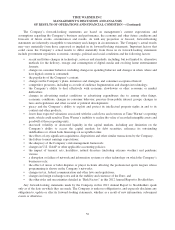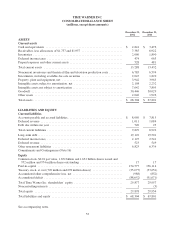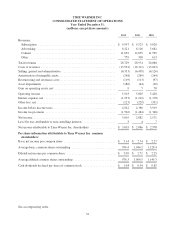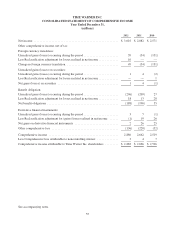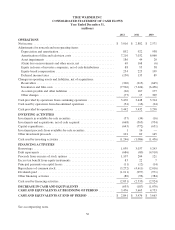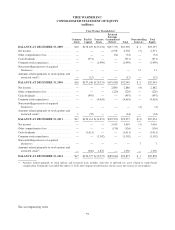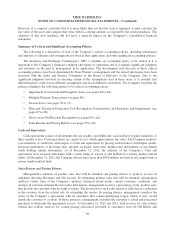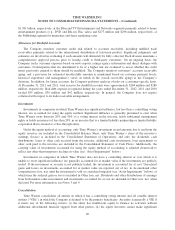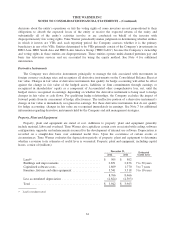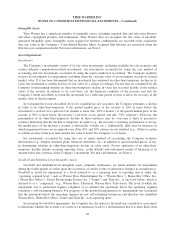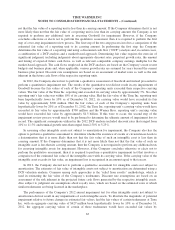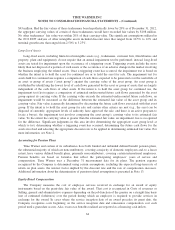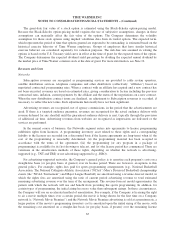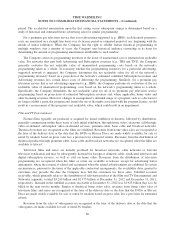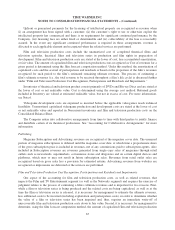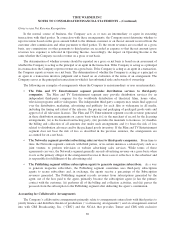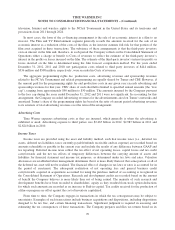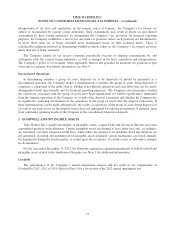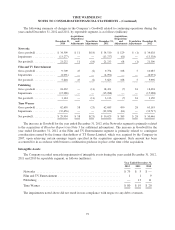Time Magazine 2012 Annual Report Download - page 78
Download and view the complete annual report
Please find page 78 of the 2012 Time Magazine annual report below. You can navigate through the pages in the report by either clicking on the pages listed below, or by using the keyword search tool below to find specific information within the annual report.TIME WARNER INC.
NOTES TO CONSOLIDATED FINANCIAL STATEMENTS – (Continued)
Intangible Assets
Time Warner has a significant number of intangible assets, including acquired film and television libraries
and other copyrighted products and tradenames. Time Warner does not recognize the fair value of internally
generated intangible assets. Intangible assets acquired in business combinations are recorded at the acquisition
date fair value in the Company’s Consolidated Balance Sheet. Acquired film libraries are amortized using the
film forecast computation model. For more information, see Note 2.
Asset Impairments
Investments
The Company’s investments consist of (i) fair-value investments, including available-for-sale securities and
certain deferred compensation-related investments, (ii) investments accounted for using the cost method of
accounting and (iii) investments accounted for using the equity method of accounting. The Company regularly
reviews its investments for impairment, including when the carrying value of an investment exceeds its related
market value. If it has been determined that an investment has sustained an other-than-temporary decline in its
value, the investment is written down to its fair value by a charge to earnings. Factors that are considered by the
Company in determining whether an other-than-temporary decline in value has occurred include (i) the market
value of the security in relation to its cost basis, (ii) the financial condition of the investee and (iii) the
Company’s intent and ability to retain the investment for a sufficient period of time to allow for recovery in the
market value of the investment.
In evaluating the factors described above for available-for-sale securities, the Company presumes a decline
in value to be other-than-temporary if the quoted market price of the security is 20% or more below the
investment’s cost basis for a period of six months or more (the “20% criterion”) or the quoted market price of the
security is 50% or more below the security’s cost basis at any quarter end (the “50% criterion”). However, the
presumption of an other-than-temporary decline in these instances may be overcome if there is persuasive
evidence indicating that the decline is temporary in nature (e.g., the investee’s operating performance is strong,
the market price of the investee’s security is historically volatile, etc.). Additionally, there may be instances in
which impairment losses are recognized even if the 20% and 50% criteria are not satisfied (e.g., if there is a plan
to sell the security in the near term and the fair value is below the Company’s cost basis).
For investments accounted for using the cost or equity method of accounting, the Company evaluates
information (e.g., budgets, business plans, financial statements, etc.) in addition to quoted market prices, if any,
in determining whether an other-than-temporary decline in value exists. Factors indicative of an other-than-
temporary decline include recurring operating losses, credit defaults and subsequent rounds of financing at an
amount below the cost basis of the Company’s investment. For more information, see Note 4.
Goodwill and Indefinite-Lived Intangible Assets
Goodwill and indefinite-lived intangible assets, primarily tradenames, are tested annually for impairment
during the fourth quarter or earlier upon the occurrence of certain events or substantive changes in circumstances.
Goodwill is tested for impairment at a level referred to as a reporting unit. A reporting unit is either the
“operating segment level,” such as Warner Bros. Entertainment Inc. (“Warner Bros.”), Home Box Office, Inc.
(“Home Box Office”), Turner Broadcasting System, Inc. (“Turner”) and Time Inc., or one level below, which is
referred to as a “component” (e.g., Warner Bros. Theatrical, Warner Bros. Television). The level at which the
impairment test is performed requires judgment as to whether the operations below the operating segment
constitute a self-sustaining business. For purposes of the goodwill impairment test, management has concluded
that the operations below the operating segment are not self-sustaining businesses and therefore has identified
Warner Bros., Home Box Office, Turner and Time Inc. as its reporting units.
In assessing Goodwill for impairment, the Company has the option to first perform a qualitative assessment
to determine whether the existence of events or circumstances leads to a determination that it is more likely than
62


